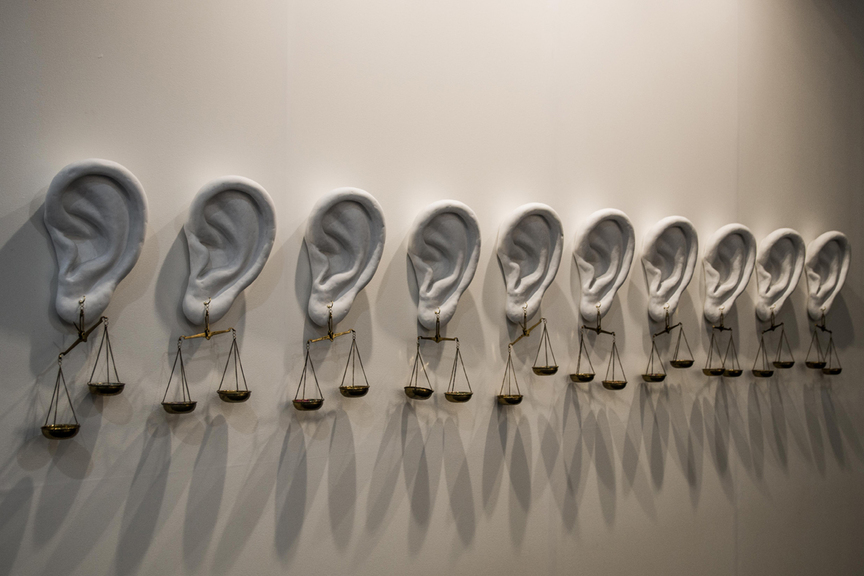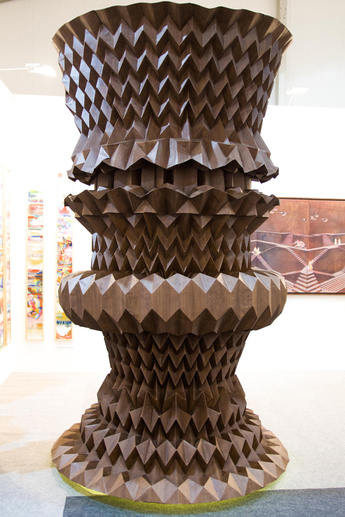
R
E
V N
E
X
T
KS RADHAKRISHNAN’s Musui on the Ladder (2016) provides an attention grabbing centerpiece at the booth of Nvya Gallery (New Delhi) at the India Art Fair 2018. All photos by Ned Carter Miles for ArtAsiaPacific.
Having attracted 6,000 visitors for its inauguration in 2008 under the name “India Art Summit,” India Art Fair (IAF) is now the largest event of its kind in the country—welcoming over 90,000 visitors in 2017. With 78 exhibitors in the latest edition—up from 72 last year—it looked promising by the end of the fair’s opening day that a healthy number of people from a variety of backgrounds would attend the first IAF under new director Jagdip Jagpal, whose résumé and socially conscious approach make it a safe bet that she is the person for the strategic development that will lead the fair into the future. Having previously worked on projects in South Asia, Africa and the United Kingdom, managed international partnerships and programs at Tate, and as governor of the London School of Economics and a development board member of the Royal College of Art, Jagpal’s objective is to expand IAF’s program and expose the best examples of the regional art scene to a wider audience. This year’s presentation was reportedly a more polished affair than previous editions, and benefitted from Jagpal’s insistence that galleries respect visitors and bring fresh works, rather than those they have been unable to sell elsewhere.
The focus was naturally on galleries from South Asia. By the end of the first day, some had done exceptionally well. Although sales data will not be released until the events draw to a close, early reports were encouraging, with New Delhi’s Art Centrix Space nearly selling out in its first year at the fair and drawing attention for Ankon Mitra’s standout piece The Divine Axis (2017–18). Anant Art, also from New Delhi, enjoyed strong interest in works by Digbijayee Khatua and Ravi Kumar Chunchula. Highlights from elsewhere included the exceptional workmanship and uncanny transformation of functional objects into static wooden sculptures in Sudarshan Shetty’s The Pieces Earth Left Behind (2018) at the GallerySKE stall, and the eerie and ethereally beautiful Loop (2013) by Zoya Siddiqui, included in the fair’s first “Project Space” and supported by Shrine Empire. Although foreign galleries were less prominent, and were subject to stricter criteria for entry, there was also an impressive showing from the likes of Dubai’s 1×1 Art Gallery and Galeria Joan Gaspar from Barcelona, the latter of which had a selection of vivid lithographs and drawings by artists including Miró, Dalì, Picasso and other European modernists, reflecting Gaspar’s observation that “Indian collectors tend to like big artists and strong colors.”
The program was not, however, confined to the tented space in New Delhi’s Okhla Industrial Area, but extended to a variety of exhibitions and events taking place not just in the northern capital city-such as a Vivan Sundaram retrospective at the Kiran Nadar Museum of Art and an exhibition of works by Alwar Balasubramaniam at Talwar Gallery-but also in the western, eastern, central and southern cities of Mumbai, Kolkata, Hyderabad and Chennai. Nor was the fair purely limited in scope to its commercial activities-it featured an educational program for the benefit of collectors and budding art enthusiasts. In-depth advice from industry experts on topics such as accessibility, authentication and intellectual property was available to professionals, while volunteers and local educational institutions sought to provide information about the arts for young people. For those even younger, there was also a “creative zone” and open-air library of children’s books set up in collaboration with Penguin Random House India.
It is common for commercial art fairs to push the idea that they are contributing to the wider community while only making symbolic gestures. India Art Fair 2018, however, appears to be putting its money where its mouth is in several ways under Jagpal’s direction. Although subtle, one of the surest signs of this was the signage on the fair grounds. In addition to a non-commercial stall by Delhi Art Gallery displaying famous examples of Indian Modernism with accompanying texts, the majority of galleries included notes on their artists so as to spread knowledge of the region’s rich and growing art scene.
Ned Carter Miles is the London desk editor of ArtAsiaPacific.
The India Art Fair runs until February 12, 2018, at the NSIC Exhibition Complex, New Delhi.
To read more of ArtAsiaPacific’s articles, visit our Digital Library.






